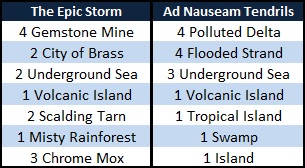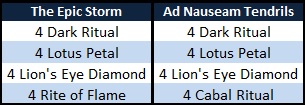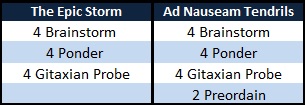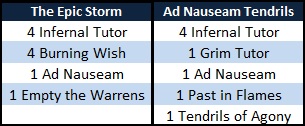Last weekend while watching the coverage of the StarCityGames.com Legacy Open in New Jersey, I couldn’t help but frown at the commentary when it came to the Top 8 match of Ad Nauseam Tendrils (ANT) versus The Epic Storm (TES). My reason for frowning? When asked to define the differences between the two decks, the commentators couldn’t suggest more than a few details—TES has Silence while ANT has more discard—some of which happened to be wrong (such as that ANT has more Rituals) instead of actually explaining the huge fundamental differences between these two decks.
From describing ANT as a deck that mainly tries to resolve Ad Nauseam (admittedly a reasonable assumption given the relic of a name we use for the deck) to describing both decks as essentially the same with slightly different card choices (I’ll admit they look quite similar), there was a lot of misleading information delivered to the captive audience during that particular game.
What this taught me is that even players with a vested interest in being well informed have difficulty realizing how different these two decks really are—and given that the question came up in the Twitter feed, my esteemed colleagues clearly aren’t the only ones who have trouble telling why they are considered different archetypes. That’s a state of affairs I’d like to rectify today.
The Fake Twins
Let’s start by taking a look at very standard lists of ANT and TES, conveniently available from the Top 8 of last weekend’s SCG Legacy Open in New Jersey:
Lands (15)
Spells (45)
- 1 Tendrils of Agony
- 4 Brainstorm
- 4 Cabal Ritual
- 4 Duress
- 4 Dark Ritual
- 1 Grim Tutor
- 3 Cabal Therapy
- 4 Lotus Petal
- 4 Lion's Eye Diamond
- 4 Infernal Tutor
- 4 Ponder
- 1 Ad Nauseam
- 2 Preordain
- 4 Gitaxian Probe
- 1 Past in Flames
Sideboard

Lands (12)
Spells (48)

The first thing I’d like to do is to establish where the misconception that these are essentially the same deck with slightly different cards comes from. The obvious answer is "both cast a bunch of spells followed by Tendrils of Agony." They also share 35 maindeck cards, including very visible key components like Lion’s Eye Diamond and Infernal Tutor.
While that may sound like a lot, check out how many cards overlap between RUG Delver and U/W/R Delver—the answer is "roughly 35"—and you’d now have to argue those are the same deck too. Obviously, that isn’t true. They’re manifestations of the same kind of strategy, sure, but with enough significant differences to clearly make them distinct decks. The same is true for ANT and TES.
As such I believe the biggest reason for these decks often being lumped together is twofold. First, people just know a lot less about storm, leading to false generalizations. Second, consciously or not, how the decks break down into functional subgroups probably plays a major role. I mean, look at this:





Who wouldn’t conclude those two decks are essentially the same? They actually seem to be almost identical, with ANT having a couple more lands instead of Chrome Mox (in itself a reasonable land replacement) and two more cantrips instead of business spells.
The problem is that while checking functional subgroups is a valuable tool, it doesn’t tell the whole story. Yes, these decks use the same basic skeleton, but because the tools they choose to fill those slots with are different, their capabilities differ significantly too. Let’s take a look at the nitty-gritty details, shall we?
Regarding lands, ANT uses a common Legacy mana base—duals, fetches, a couple of basics—while TES only plays a bare minimum of these and instead uses the five-color lands, Gemstone Mine and City of Brass, as well as Chrome Mox, a permanent mana source that’s also an accelerator, to reach the seemingly critical fifteen permanent mana source count.
The effects of this are quite profound. The only way for TES to play around Wasteland is to hold back fetchlands, a very unlikely thing to be able to do in a deck heavily focused on the early game. In addition, TES has only three fetchlands to try to maximize its cantrips by shuffling after resolving them. The Chrome Moxen also make it so that a TES player will regularly have to make significant sacrifices to establish their mana base (as in exiling relevant cards from their hand).
That all sounds negative, but here’s the upside. By running Gemstone Mines and City of Brasses, TES is significantly less likely to draw lands that don’t cast all its spells and gets to run the most powerful option for any desired effect.
The five-color lands allow you to fluidly cast Rite of Flame, Brainstorm, and Dark Ritual in the same deck and, most importantly, make it so that you have access to the most comprehensive protection spell available to any combo deck, Silence.
Replacing the other three lands with Chrome Mox as the permanent mana source of choice while costly in the card advantage department makes you more likely to have multiple starting mana available in the early game and greatly increases the likelihood of Ad Nauseam revealing a lethal combination of cards. The biggest reason Ad Nauseam may not win the game is usually not having mana floating to get going with a million cards in hand after all.
We see this focus on cheap early effectiveness repeated when looking at the actual fast mana in the list. Instead of the more powerful Cabal Ritual—you get paid with an effective Black Lotus for reaching threshold!—TES uses Rite of Flame. This has two effects. First, you’re more likely to find two Rite of Flames than to reach threshold on turn 1 or 2, meaning you’re more likely to benefit from your weak ritual’s advantage early in the game. In addition, Rite costing only a single mana works a lot better with Ad Nauseam. Look at it this way: you could draw twenty Rite of Flames but only ten Cabal Rituals! Given enough castings of Legacy’s Yawgmoth’s Bargain replacement, Rite of Flame’s lower cost is sure to make itself felt.
What ANT gains, on the other hand, is turn 3+ potential. The additional mana provided by threshed Cabal Rituals makes it significantly easier to abuse Past in Flames, win by straight Tutor chaining, and punch through an accumulation of taxing counters later in the game. The fact that both its rituals cost and produce black mana also reduces mana base requirements and makes them easier to chain into each other.
As far as disruption is concerned, we see TES taking advantage of its five-color mana base by running the most powerful piece of protection available in Silence. Sure, there are a couple of discard spells to round out its protection suite, but TES really loves Silence. It always demands a counter, and if said counter isn’t forthcoming, you know you’re safe to win. Silence also forces the opponent to cast countermagic (instead of just revealing a hand with a mix of different, relevant soft counters like one could against a Duress).
But what Silence gains as a piece of protection it loses in flexibility. Sure, if protection is unnecessary, you get to "chant walk" the opponent; that is to force them to skip a turn of casting spells, often the equivalent of a Time Walk. Other than buying a turn, though, Silence doesn’t really fill any additional roles one might want to have access to.
Relying solely on discard like ANT does allows you to take a very different stance if you so choose: that of a heavy disruption deck. Instead of trying to deal with the opponent’s disruption, you get to go ahead and dismantle their entire game plan, leaving them with a hand full of meaningless cardboard just like Jund or Deadguy Ale would.
Given the nature and speed of storm combo, this kind of faux Mind Twist allows the deck to actually take the control role in situations and matchups one wouldn’t expect to play out this way.
Once again TES’s choice is made to maximize its ability to push through the win as early as possible, while ANT chooses the disruption most likely to give it a significant edge in a longer game.
That leaves us to look at the engine and library manipulation. Here ANT trades more business in the form of Burning Wish for a couple of cantrips, a Grim Tutor, and a maindeck Past in Flames. We can easily conclude from this is that Past in Flames is much more important to ANT than it is to TES and that ANT will have to cantrip more often until finding a business spell to win with (five tutors in ANT compared to eight in TES). Obviously, having Burning Wish also means TES can get out of situations ANT will never win through, maindeck Gaddock Teeg being the big one.
In addition, TES has Empty the Warrens maindeck, whereas ANT has Tendrils of Agony (though there are quite a few ANT players that will have access to both in the maindeck). While this is in a large part enabled by Burning Wish—no one wants a storm deck that can’t win instantly—even ANT decks supporting a couple of Burning Wishes will have maindeck Tendrils.
These differences signify that TES is going to use Empty the Warrens to snag a win a lot more often—hence it being in the main—and that it expects to have more resources at its disposal if it chooses to win with Tendrils. The extra 1R for Burning Wish has been considered "free" during deck construction after all.
Beyond the Skeleton
After that in-depth look at the card choices, here’s the picture we have right now:
TES has more fast mana than ANT does, more business, and its protection spells are more efficient in the early game. Its mana cost curve is also markedly lower than that of ANT. To reach this state of affairs, TES sacrifices in mana base resilience/longevity and the raw power level of accelerants. Playing cards like Chrome Mox and Gemstone Mine with fewer cantrips also means that TES will exhibit higher variance; that is to say you are more likely to draw situationally terrible cards than you are with ANT.
As a result, it relies more on the mulligan to fix its hand. The dual-fetch mana base makes ANT’s cantrips much better than TES’s in games going beyond turn 3—you get to fetch away bad cards post Ponder or Brainstorm more often—and it also has fewer clunky cards and spell combinations begging for mana issues that would force you to mulligan. I mean, have you ever drawn more than one Chrome Mox? Or tried to cast Silence, Dark Ritual, and Rite of Flame during the same turn? Let me tell you, having all of these sure forces you to mulligan with care.
Do you realize the trend? Every time the two decks choose different tools, TES goes for the fast, raw power option, while ANT goes for the effect that will give it bigger strength a little later in the game. And that’s really where the two decks differ the most: in their approach to the game.
TES wants to blitz the opponent. The deck is built to maximize its ability to win (or produce an insurmountable amount of Goblins) on turns 1 and 2, sacrificing a lot of mid-to-late-game grinding potential to make explosive early turns happen. ANT, on the other hand, is built to excel at grinding, playing turn after turn until the opponent is out of options and just dies because ANT hit critical mass along the way.
This is also reflected in their storm engines of choice. TES has access to a couple of backup engines through Burning Wish but uses Ad Nauseam as its go-to spell generator in most games it doesn’t just make Goblins. Everything, from lower-cost Rite of Flames to Chrome Mox and the absence of the four-casting cost Tendrils of Agony from the maindeck, serves to make Ad Nauseam as powerful as it can possibly be. In TES if you cast Ad Nauseam with more than thirteen or fourteen life, you’re virtually assured to flip over an on-turn kill, though there still is variance involved.
Ironically enough our other contender, ANT (as in Ad Nauseam Tendrils), is actually a terrible Ad Nauseam deck to the point that a number of pilots—me included—are experimenting with getting rid of the card entirely or keeping it only in the sideboard. I’ve died more than once casting Ad Nauseam from twenty and have to pass the turn after resolving it roughly half the time when I don’t have a ton of mana floating. Not really the greatest for the same reason that Doomsday, go isn’t the greatest of plans.
Instead, modern ANT is really a Past in Flames deck. It has stronger rituals than TES (once threshold is turned on) and is more prepared to spend a couple of turns setting up before trying to kill the opponent. While digging for any missing pieces, its graveyard fills up, more and more discard ends up being cast, and its final turn usually consists of redoing at least half the stuff that happened before. And best of all, none of this actually cares about how much life you have left. Given that ANT is set up to play a slower game, this is a crucial advantage of the Past in Flames plan.
Don’t get me wrong. When I say ANT is a slow deck set up to grind, you have to look at this in the context of a storm combo deck. If ANT planned on actually playing a long game against everyone, it wouldn’t just be a different deck than TES; it would be a terrible one. There is neither removal nor blockers in the deck, meaning an actual long game against anyone deploying a Tarmogoyf on turn 2 is utterly unwinnable.
Both TES and ANT are fast combo decks easily capable of dispatching the opponent by turn 3. ANT is only slow in comparison to TES. Compared to something like Goblins, Zoo, or Esper Stoneblade, it’s still lightning fast.
To give you some numbers, I’d expect TES to be slightly worse than a turn 2 deck on average; that is to say it will be able make its game-winning move against zero interaction by turn 2 a lot of the time. ANT, on the other hand, is something like a turn 2.6 or 2.7 deck. You can usually expect it to be ready to kill a goldfish by turn 3, but it won’t consistently go off before that.
The Age-Old Debate
There’s an old debate that turns up again and again. Which is the better Tendrils deck, TES or ANT? This usually comes up when someone asks which of the two decks they should pick up or when someone wonders why the heck two Tendrils of Agony decks exist side by side.
There are fervent supporters ready to argue heatedly on both sides, but personally I consider the whole question flawed. Looked at from a win percentage perspective, both decks are pretty evenly matched. I don’t think ANT is actually better than TES, but I also don’t think TES is better than ANT as far as winning is concerned. However, each deck is much better depending on who’s playing it.
TES rewards daring, reading the opponent for Force of Will, and seeing early openings. It needs to be played aggressively. Sure, the deck can grind reasonably well—one of the benefits of playing a flexible deck like storm combo over something like Sneak and Show is that its game plan is highly adaptable—but it would much rather try to punch through during the early turns with a single piece of disruption.
Basically, TES is what you should play if you’d like a Belcher deck that doesn’t auto-lose to Force of Will and is about a million times more flexible (and complicated). Speed is really what gives you your strength, and everything else is there to make sure you still have game if winning fast turns out not to be an option.
What you want to do is drop your hand on the table on turn 1. What you can do is slow down to get through when that isn’t an option.
ANT, on the other hand, is the control player’s Tendrils deck. Your plan going in is to sit around and massage your hand and library while taking out your opponent’s options for as long as they will let you. Only when you’ve taken control of the game in this way—or when you know for sure your opponent can’t interact on the stack—should you start casting spells that will eventually lead to a game win. ANT doesn’t usually win because the opponent is dead before they can do anything. Instead, it leverages the threat of a fast kill to force the opponent into a position where it can steal control of the game for long enough to just win.
What you want to do is sit around and do nothing until the opponent is helpless before you. What you can do is just kill people before they’re ready to play.
This is one case where there’s no objective answer; neither TES nor ANT is the better deck. One of them will be the better deck for you though.
Facing TES and ANT
I’m not going to include a full "how to play against storm" guide today. That subject needs at least a full article of its own. However, assuming you already know how to play against combo in general, there are some important differences in how you should approach a match against TES compared to one against ANT as a result of their different focus.
It all boils down to this essentially. Against ANT on the draw, tapping out for turn 1 Delver with only Spell Pierce as protection is not only fine but usually a good play. Even if your opponent has the kill in hand, they’re likely to just keep sculpting until they have disruption to punch through what you might have (Gitaxian Probe can be a pain there though). The longer you give them to sculpt, the more likely they’re going to get through whatever defenses you have. Using the same line against TES, on the other hand, is just begging to find yourself on the wrong end of a dozen Goblins or a lethal Tendrils of Agony.
In more general terms, you need to play much more defensively when facing TES. From turn 1 onward, you need to constantly make sure to never give them an opening since doing so will likely end with your death. You also need to try to mise them more to benefit from their lower resilience—Wastelanding a TES player’s first land is often the best thing you can do.
Against ANT, you still need to be careful, but you’re usually safe—assuming you play blue to at least threaten the Force of Will—until they make their third land drop. At the same time, putting a clock on them is actually more important than disrupting them on turn 1. Given enough time, ANT will punch through anything but a hard lock, so limiting the number of turns they get is of paramount importance.
Completely Compared
Alright, that should be enough to get my point across. Staying objective while comparing the two most popular manifestations of the storm combo archetype in Legacy isn’t always easy—I obviously much prefer ANT to TES, as evidenced by having written roughly half a dozen articles on the former and none on the latter—but I hope I made a solid job of it today.
The real key to understanding both decks is to look where they focus their strength. TES peaks very early in the game and loses power from there on out. ANT, on the other hand, takes more time to reach its full potential, but once it’s there it very nearly plateaus. Assuming you’re still alive, you’re about as good at winning on turn 10 as you are at doing so on turn 4. Keep that in mind when deciding which one to learn or what to do when a storm pilot sits down on the other side of the table—if you do, things should work out nicely.
That’s it from me for today. Let me know if this kind of article is something you’d be interested in reading for other decks that are similar yet different. Also make sure to let me know in the comments if you feel I erred somewhere, misrepresented something, or simply wasn’t clear—I’ll do my best to address anything that comes up.
One last question before we close for today. I’m planning to write a "how to learn storm" type of article soon; is that something you’d like to read? And, more importantly, would you like to read it next week, or would that be too much storm in a row? Make sure to let me know in the comments!
Until next time, remember that just because something looks like a duck doesn’t actually mean it’s a duck!*
*If it also swims and quacks like one, though, you probably do have a duck. Just sayin’ . . .
